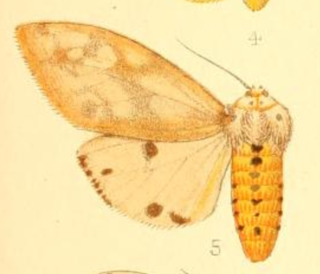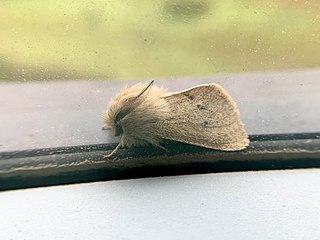
The buff ermine is a moth of the family Erebidae. It is sometimes placed in the genus Spilosoma. The species was first described by Johann Siegfried Hufnagel in 1766. It is found throughout the temperate belt of the Palearctic region south to northern Turkey, Georgia, Kazakhstan, southern Siberia, eastern Mongolia, Amur Region, China, Korea and Japan.

Hagenia is a monotypic genus of flowering plant with the sole species Hagenia abyssinica, native to the high-elevation Afromontane regions of central and eastern Africa. It also has a disjunct distribution in the high mountains of East Africa from Sudan and Ethiopia in the north, through Kenya, Uganda, Rwanda, Burundi, Democratic Republic of Congo, and Tanzania, to Malawi and Zambia in the south.

Spilosoma virginica is a species of moth in the subfamily Arctiinae. As a caterpillar, it is known as the yellow woolly bear or yellow bear caterpillar. As an adult, it is known as the Virginian tiger moth.

Diaphora mendica, the muslin moth, is a moth of the family Erebidae. It is found in the Palearctic realm east to Lake Baikal.

Spilosoma lubricipeda, the white ermine, is a moth of the family Erebidae. It is found throughout the temperate belt of Eurasia from Europe through Kazakhstan and southern Siberia to Amur Region, China, Korea and Japan. In China several sibling species occur.

Phragmatobia fuliginosa, the ruby tiger, is a moth of the family Erebidae.

Spilosoma is a genus of moths in the family Erebidae originally described by John Curtis in 1825. A very heterogeneous group, it is in need of review by the scientific community, as certain species probably need reclassification into their own genera.

Cosmorhoe is a monotypic moth genus in the family Geometridae erected by Jacob Hübner in 1825. Its only species, Cosmorhoe ocellata, the purple bar, was described by Carl Linnaeus in his 1758 10th edition of Systema Naturae.

Spilosoma sagittifera is a species of moth of the family Erebidae. It was described by Frederic Moore in 1888. It is found in India, Nepal, China and Taiwan.

Spilosoma batesi is a moth of the family Erebidae. It was described by Walter Rothschild in 1910. It is found in Nigeria, Cameroon, Congo and Zaire.

Spilosoma obliqua, the jute hairy caterpillar or Bihar hairy caterpillar, is a moth of the family Erebidae. It is found in south-eastern Afghanistan, northern Pakistan, India, Bhutan, Bangladesh and Myanmar.
Diacrisia echo is a moth of the family Erebidae. It was described by Walter Rothschild in 1910. It is found in Asia.

Spilosoma curvilinea is a species of moth of the family Erebidae. It was described by Francis Walker in 1855. It is found in Cameroon, Republic of the Congo, Democratic Republic of the Congo, Ghana, Ivory Coast, Kenya, Nigeria, Senegal, Sierra Leone, Sudan, Tanzania, the Gambia and Uganda.

Pseudohemihyalea edwardsii, or Edwards' glassy-wing, is a moth in the family Erebidae. It was described by Alpheus Spring Packard in 1864. It is found in the United States from western Oregon and the Columbia Gorge in southern Washington south to California, in the south-west east to western New Mexico. The habitat consists of oak woodlands and mixed hardwood forests at low elevations.

Spilosoma erythrozona is a moth in the family Erebidae. It was described by Vincenz Kollar in 1844. It is found in China, eastern Afghanistan and Himalayas.

Spilosoma pteridis, the brown tiger moth, is a moth in the family Erebidae. It was described by Henry Edwards in 1875. It is found in the United States in western Oregon and Washington, British Columbia and northern Idaho. The habitat consists of wet forests west of the Cascades, including coastal rainforests, low elevation mixed hardwood-conifer forests, as well as higher elevation conifer forests in the Cascades.

Spilosoma crossi is a moth in the family Erebidae. It was described by Rothschild in 1910. It is found in Nigeria and Gambia.

Spilosoma rava is a moth in the family Erebidae. It was described by Herbert Druce in 1898. It is found in Cameroon, the Democratic Republic of the Congo, Equatorial Guinea, Gabon, Ghana, Kenya, Liberia, Nigeria, Senegal, the Gambia and Uganda.
Spilosoma dubia, the dubious tiger moth, is a moth in the family Erebidae. It was described by Francis Walker in 1855. It is found from south-eastern Canada west to Alberta and in the eastern United States. The habitat consists of aspen parkland and southern boreal forests.

Spilosoma vagans, the wandering diacrisia or wandering tiger moth, is a moth in the family Erebidae. It was described by Jean Baptiste Boisduval in 1852. It is found in western North America, from southern California, southern Utah and central Colorado north to southern British Columbia and south-western Alberta. The habitat consists of drier forests, including open ponderosa pine forests and mixed hardwood-conifer forests.



















